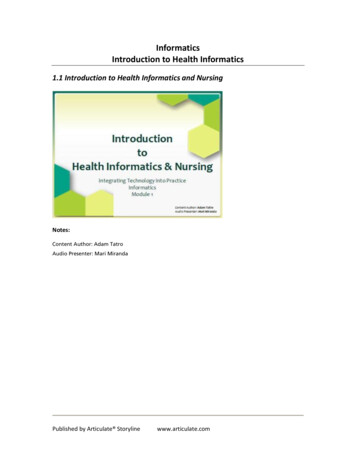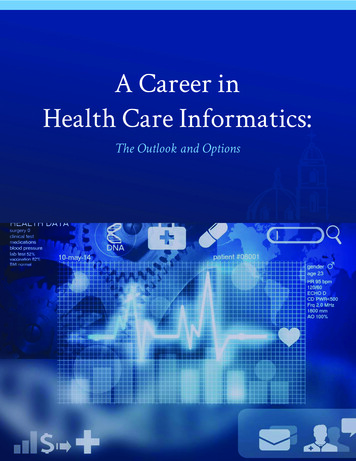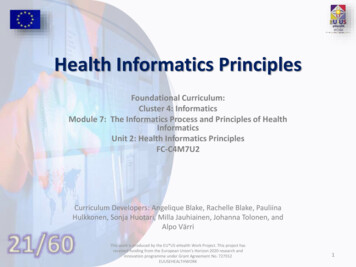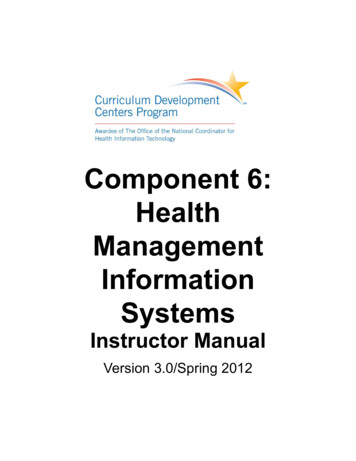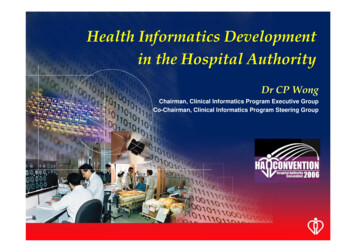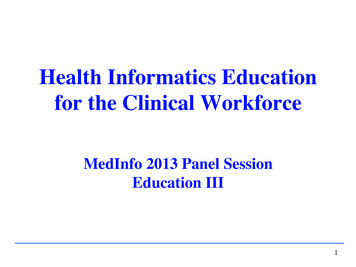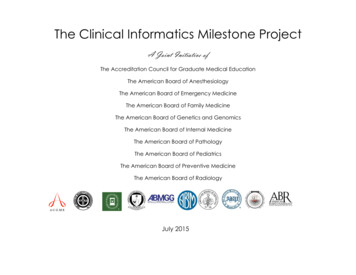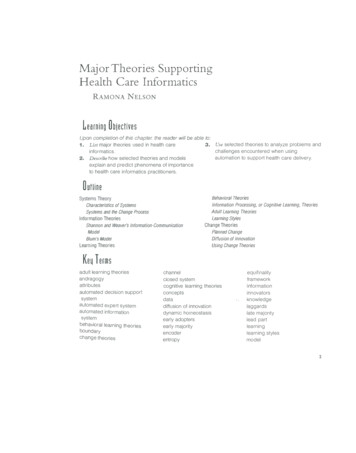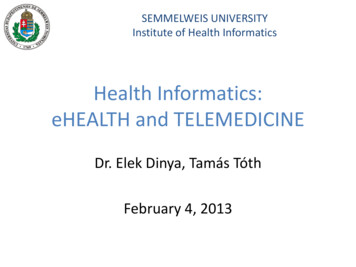
Transcription
SEMMELWEIS UNIVERSITYInstitute of Health InformaticsHealth Informatics:eHEALTH and TELEMEDICINEDr. Elek Dinya, Tamás TóthFebruary 4, 2013
Agenda Basic terms of health informatics– eHealth– Telehealth– Telemedicine– mHealth Examples of eHealth solutions
Health informatics Health informatics (also called health care informatics,healthcare informatics, medical informatics, nursinginformatics, or biomedical informatics) is a disciplineat the intersection of information science, computerscience, and health care. It deals with the resources, devices, and methodsrequired to optimize the acquisition, storage, retrieval,and use of information in health and biomedicine. Health informatics tools include not only computersbut also clinical guidelines, formal medicalterminologies, and information and communicationsystems. It is applied to the areas of nursing, clinicalcare, dentistry, pharmacy, public health, occupationaltherapy, and (bio)medical research.
eHealth eHealth (also written e-health) is a relativelyrecent term for healthcare practice supportedby electronic processes and communication– Dating back to at least 50’years (from the firstcomputers).– Usage of the term varies: some would argue it isinterchangeable with health informatics with abroad definition covering electronic/digitalprocesses in health– Others use it in the narrower sense of healthcarepractice using the Internet.
Forms of e-healthThe term eHealth is often, particularly in theU.K. and Europe, used as an umbrella termthat includes telehealth, electronic medicalrecords, and other components of health IT.The term can encompass a range of services orsystems that are at the edge ofmedicine/healthcare and informationtechnology (IT)
Telemedicine Telemedicine is a rapidly developing application ofclinical medicine where medical information istransferred through interactive audiovisual media for thepurpose of consulting, and sometimes remote medicalprocedures or examinations.– Telemedicine may be as simple as two health professionals discussing a caseover the telephone, or as complex as using satellite technology andvideoconferencing equipment to conduct a real-time consultation betweenmedical specialists in two different countries.– Telemedicine generally refers to the use of communications and informationtechnologies for the delivery of clinical care (ICT).– Care at a distance (also called in absentia care), an old practice which wasoften conducted via post. There has been a long and successful history of inabsentia health care which, thanks to modern communication technology,has evolved into what we know as modern telemedicine.
Telehealth or telemedicine? The terms eHealth and telehealth are at timesincorrectly interchanged with telemedicine.Like the terms "medicine" and "health care",telemedicine often refers only to the provisionof clinical services while the term telehealthcan refer to clinical and non-clinical servicessuch as medical education, administration,and research.
mHealth or m-Health Includes the use of mobile devices incollecting aggregate and patient level healthdata, providing healthcare information topractitioners, researchers, and patients, realtime monitoring of patient vitals, and directprovision of care (via mobile telemedicine).
Consumer health informatics (CHI) Use of electronic resources on medical topics by healthy individuals orpatients. Consumer Health Informatics helps bridge the gap between patients andhealth resources. The Kaiser model is an example of allowing patients toremotely communicate with their physicians or other healthcareprofessionals. Consumer Health Informatics include technologies focused on patients asthe primary users to health information. Consumer Health Informatics includes: Information Resources,Communications, Remote Monitoring, Videoconferencing, andTelepresence. Consumer health informatics is the branch of medical informatics thatanalyses consumers' needs for information; studies and implementsmethods of making information accessible to consumers; and models andintegrates consumers' preferences into medical information systems.
Agenda Basic terms of health informatics eHealth Telehealth Telemedicine mHealth Examples of eHealth solutions
Healthcare Information SystemsRefer to software solutions for appointmentscheduling, patient data management, workschedule management and otheradministrative tasks surrounding health
Electronic health records An electronic health record (EHR) (alsoelectronic patient record (EPR) orcomputerised patient record) is an evolvingconcept defined as a systematic collection ofelectronic health information about individualpatients or populations. Enabling the communication of patient databetween different healthcare professionals(specialists etc.).
Electronic health records
Electronic health records It is a record in digital format that is capable of beingshared across different health care settings, by beingembedded in network-connected enterprise-wideinformation systems. Such records: may include a whole range of data incomprehensive or summary form, including demographics,medical history, medication and allergies, immunizationstatus, laboratory test results, radiology images, vitalsigns, personal stats like age and weight, and billinginformation. Its purpose: can be understood as a complete record ofpatient encounters that allows the automation andstreamlining of the workflow in health care settings andincreases safety through evidence-based decision support,quality management, and outcomes reporting.
Electronic health records
Technical issues Standard for communication of health data– ANSI X12 (EDI) - transaction protocols used for transmitting patientdata. Popular in the United States for transmission of billing data.– CEN's TC/251 provides EHR standards in Europe including: EN 13606, communication standards for EHR information CONTSYS (EN 13940), supports continuity of care record standardization. HISA (EN 12967), a services standard for inter-system communication in aclinical information environment.– Continuity of Care Record - ASTM International Continuity of CareRecord standard– DICOM - an international communications protocol standard forrepresenting and transmitting radiology (and other) image-based data,sponsored by NEMA (National Electrical Manufacturers Association)– HL7 - a standardized messaging and text communications protocolbetween hospital and physician record systems, and between practicemanagement systems– ISO - ISO TC 215 provides international technical specifications forEHRs. ISO 18308 describes EHR architectures
Meaningful UseThe meaningful use of EHRs intended by the US government incentives iscategorized as follows: Improve care coordination Reduce healthcare disparities Engage patients and their families Improve population and public health Ensure adequate privacy and security.The Obama Administration’s Health IT program intends to use federalinvestments to stimulate the market of electronic health records: Incentives: to providers who use IT Strict and open standards: To ensure users and sellers of EHRs worktowards the same goal Certification of software: To provide assurance that the EHRs meet basicquality, safety, and efficiency standards.
Telemedicine - History African villagers used smoke signals to warnpeople to stay away from the village in case ofserious disease. In the early 1900s, people living in remoteareas in Australia used two-way radios,powered by a dynamo driven by a set ofbicycle pedals, to communicate with the RoyalFlying Doctor Service of Australia. This service is still running!
Store-and-forward telemedicine It involves acquiring medical data (like medical images,biosignals etc.) and then transmitting this data to a doctor ormedical specialist at a convenient time for assessment offline. It does not require the presence of both parties at the sametime. Dermatology (cf: teledermatology), radiology, and pathologyare common specialties that are conducive to asynchronoustelemedicine. A properly structured Medical Record preferably in electronicform should be a component of this transfer. A key difference between traditional in-person patientmeetings and telemedicine encounters is the omission of anactual physical examination and history. The store-andforward process requires the clinician to rely on a historyreport and audio/video information in lieu of a physicalexamination.
Remote monitoring Enables medical professionals to monitor a patient remotelyusing various technological devices. Primarily used for managing chronic diseases or specificconditions, such as heart disease, diabetes mellitus, orasthma. These services can provide comparable health outcomes totraditional in-person patient encounters, supply greatersatisfaction to patients, and may be cost-effective.
Monitoring of vital signs
Remote monitoring of vital signs22
Interactive telemedicine Provides real-time interactions between patient andprovider Include phone conversations, online communication andhome visits. Many activities such as history review, physicalexamination, psychiatric evaluations and ophthalmologyassessments can be conducted comparably to thosedone in traditional face-to-face visits. “Clinician-interactive” telemedicine services may be lesscostly than in-person clinical visits.
Benefits and uses Telemedicine can be extremely beneficial forpeople living in isolated communities and remoteregions and is currently being applied in virtually allmedical domains. Patients who live in such areascan be seen by a doctor or specialist, who canprovide an accurate and complete examination,while the patient may not have to travel or wait thenormal distances or times like those fromconventional hospital. Specialties that use telemedicine often use a 'tele-'prefix; for example, telemedicine as applied byradiologists is called 'teleradiology'. Similarlytelemedicine as applied by cardiologists is termedas 'telecardiology', etc.
Benefits and uses Telemedicine is also useful as a communication tool between ageneral practitioner and a specialist available at a remote location. Telemedicine can be used as a teaching tool, by which experiencedmedical staff can observe, show and instruct medical staff inanother location, more effective or faster examination techniques. It improved access to healthcare for patients in remote locations. "Telemedicine has been shown to reduce the cost of healthcare andincrease efficiency through better management of chronic diseases,shared health professional staffing, reduced travel times, and feweror shorter hospital stays." Several studies have documented increase patient satisfaction oftelemedicine over past fifteen years.
Benefits and uses The first interactive telemedicine system, operating over standardtelephone lines, for remotely diagnosing and treating patients requiringcardiac resuscitation (defibrillation) was developed and marketed byMedPhone Corporation in. A year later the company introduced a mobilecellular version, the MDphone. Twelve hospitals in the U.S. served asreceiving and treatment centers. Monitoring a patient at home using known devices like blood pressuremonitors and transferring the information to a caregiver is a fast growingemerging service. These remote monitoring solutions have a focus oncurrent high morbidity chronic diseases and are mainly deployed for theFirst World. In developing countries a new way of practicing telemedicine is emergingbetter known as Primary Remote Diagnostic Visits, whereby a doctor usesdevices to remotely examine and treat a patient. This new technology and principle of practicing medicine holds significantpromise of improving on major health care delivery problems, in forinstance, Southern Africa, because Primary Remote DiagnosticConsultations not only monitors an already diagnosed chronic disease, buthas the promise to diagnose and manage the diseases a patient willtypically visit a general practitioner for.
Telecardiology ECG or electrocardiograph can be transmitted usingtelephone and wireless. Einthoven, the inventor of theECG, actually did tests with transmission of ECGthrough telephone lines. This was because the hospitaldid not allow him to move patients outside the hospitalto his laboratory for testing of his new device. In 1906Einthoven came up with a way to transmit the datafrom the hospital directly to his lab. Teletransmission of ECG using indigenous methods.One of the oldest known telecardiology system(teletransmission of ECG) was established in Gwalior,India in 1975 at GR Medical college by Dr. Ajai Shanker,Dr. S. Makhija, P.K. Mantri using indegenous techniquefor the first time in India.
Teleradiology Teleradiology is the ability to send radiographic images (x-rays, CT,MR, PET/CT, SPECT/CT ) from one location to another The most typical implementation are two computers connected viaInternet. The computer at the receiving end will need to have ahigh-quality display screen that has been tested and cleared forclinical purposes. Sometimes the receiving computer will have aprinter so that images can be printed for convenience. Today's Internet bandwidth enables the use of new technologies forteleradiology : the image reviewer can now have access to distantservers in order to view an exam. Therefore, they do not needparticular workstations to view the images ; a standard PC and DSLconnection is enough to reach keosys central server. No particularsoftware is necessary on the PC and the images can be reachedfrom wherever in the world. Teleradiology is the most popular use for telemedicine andaccounts for at least 50% of all telemedicine usage.
Teleradiology
MRI (Magnetic Resonance Imaging)
Telepsychiatry Telepsychiatry, another aspect oftelemedicine, also utilizes videoconferencingfor patients residing in underserved areas toaccess psychiatric services. It offers wide rangeof services to the patients and providers, suchas consultation between the psychiatrists,educational clinical program, diagnosis andassessment, medication therapymanagement, etc.
Teledentistry is the use of information technology andtelecommunications for dental care,consultation, education, and public awarenessin the same manner as telehealth andtelemedicine.
Robotic surgery Computer-assisted surgery, and robot-assisted surgery are terms forvarious technological developments that currently are developed tosupport a range of surgical procedures. Robot-assisted surgery was developed to overcome limitations ofminimally invasive surgery. Instead of directly moving the instruments thesurgeon uses a computer console to manipulate the instruments attachedto multiple robot arms. The computer translates the surgeon’s movements, which are then carriedout on the patient by the robot. Other features of the robotic systeminclude, for example, an integrated tremor filter and the ability for scalingof movements (changing of the ratio between the extent of movements atthe master console to the internal movements of the instrumentsattached to the robot). The console is located in the same operating room as the patient, but isphysically separated from the operative workspace. Since the surgeondoes not need to be in the immediate location of the patient while theoperation is being performed, it can be possible for specialists to performremote surgery on patients. Robots can perform surgery without a humansurgeon.
History The world's first surgical robot was the "Arthrobot", which was developedand used for the first time in Vancouver, BC, Canada in 1983. The robotwas developed by a team led by Dr. James McEwen and Geof Auchinlek, incollaboration with orthopaedic surgeon, Dr. Brian Day. NationalGeographic produced a movie on robotics which featured the Arthrobot. In related projects at that time, other medical robots were developed,including a robotic arm that performed eye surgery and another thatacted as an operating assistant, and handed the surgeon instruments inresponse to voice commands. 1985 a robot, the PUMA 560, was used to place a needle for a brain biopsyusing CT guidance. In 1988, the PROBOT, developed at Imperial College London, was used toperform prostatic surgery. The ROBODOC from Integrated Surgical Systems was introduced in 1992 tomill out precise fittings in the femur for hip replacement. Further development of robotic systems was carried out by IntuitiveSurgical with the introduction of the da Vinci Surgical System andComputer Motion with the AESOP and the ZEUS robotic surgical system.(Intuitive Surgical bought Computer Motion in 2003; ZEUS is no longerbeing actively marketed.)
Advantages and disadvantages Major advances aided by surgical robots have been remote surgery,minimally invasive surgery and unmanned surgery. Some major advantages of robotic surgery are precision,miniaturization, smaller incisions, decreased blood loss, less pain, andquicker healing time. Further advantages are articulation beyond normal manipulation andthree-dimensional magnification, resulting in improved ergonomics. Robotic techniques are also associated with reduced duration ofhospital stays, blood loss, transfusions, and use of pain medication. With a the cost of the robot at 1,200,000 dollars and disposablesupply costs of 1,500 per procedure, the cost of the procedure ishigher. Additional surgical training is needed to operate the system Higher expectations may explain higher rates of dissatisfaction andregret.
da Vinci Surgical Systemwith robotic arm operating table
A surgical team at Hackensack University Medical Centeruses the Da Vinci robot. (NYTIMES, February 12, 2008)http://www.youtube.com/watch?v nhusxZE7dJ4
Applications General surgeryCardiology and electrophysiologyGastrointestinalGynecologyUrology etc.
Artificial Intelligence
Definition Artificial intelligence (AI) is the intelligence ofmachines and the branch of computer sciencethat aims to create it. AI textbooks define the field as „the study anddesign of intelligent agents” where anintelligent agent is a system that perceives itsenvironment and takes actions that maximizeits chances of success
AI in medicine 'Medical artificial intelligence is primarilyconcerned with the construction of AIprograms that perform diagnosis and maketherapy recommendations. Unlike medicalapplications based on other programmingmethods, such as purely statistical andprobabilistic methods, medical AI programsare based on symbolic models of diseaseentities and their relationship to patientfactors and clinical manifestations.‘Clancey and Shortliffe, 1984
Examples Expert systems contain medical knowledge,and are able to reason with data fromindividual patients to come up with reasonedconclusions.– Generating alerts and reminders– Diagnostic assistance– Therapy critiquing and planning– Agents for information retrieval– Image recognition and interpretation
The future?
Virtual reality Virtual reality (VR) is a term that applies tocomputer-simulated environments that cansimulate places in the real world, as well as inimaginary worlds. Users can interact withthe computer-generatedenvironment
VR System
U.S. Navy personnel using a VRparachute trainer
VR in medicine Surgical training and planningMedical educationRadiation treatment planning and controlRehabilitation and sports therapyDisability solutionsNeurological evaluationPsychiatric and behavioural health (e.g.treatment for various phobias)
Mobile health obile-Health-market-snapshot/4468557
Some mHealth apps
THANK YOU FOR YOUR ATTENTION!
Health informatics Health informatics (also called health care informatics, healthcare informatics, medical informatics, nursing informatics, or biomedical informatics) is a discipline at the intersection of information science, computer science, and health

